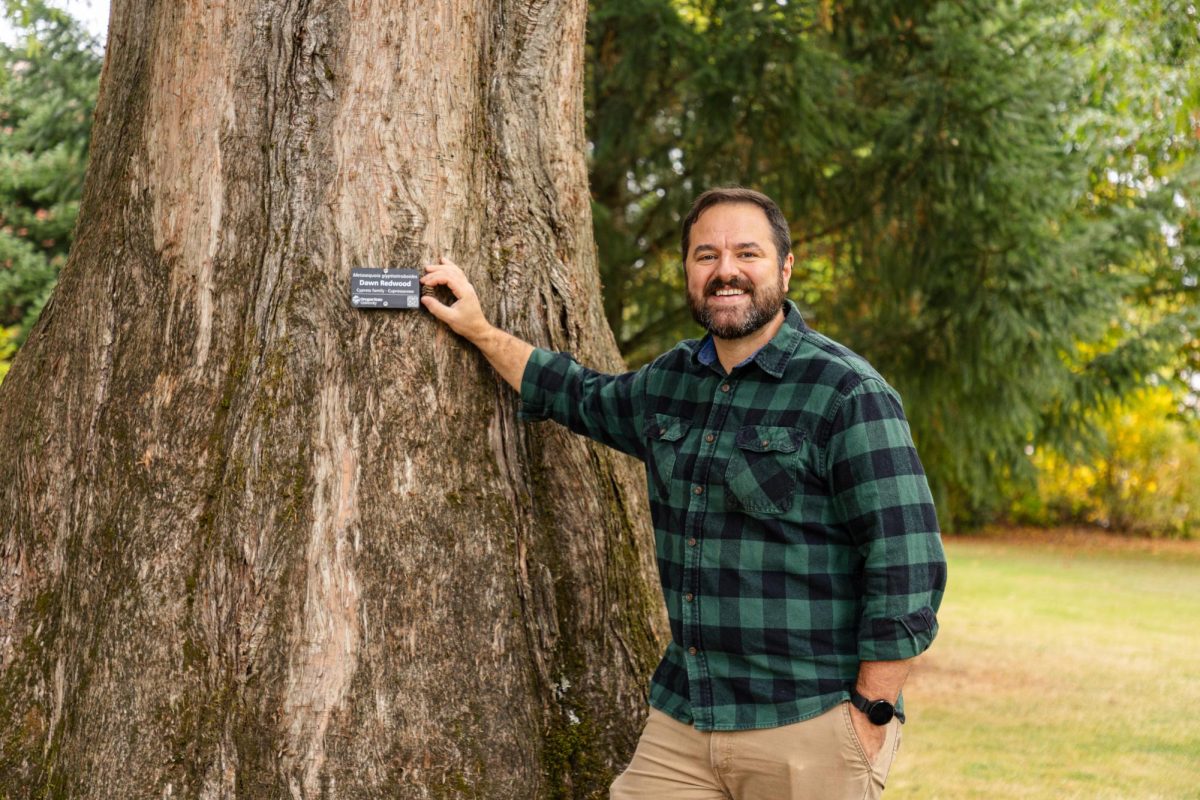The students at Oregon State University attend more than just a land grant university. Beaver Nation walks the grounds of a living, breathing, growing laboratory and arboretum.
Dan Blanchard is OSU’s campus arboretum curator of living plant collections and teaches horticulture in the College of Agricultural Science.
In 2021 Ryan Contreras brought Blanchard on as a graduate student. Contreras is a professor at OSU in the Department of Horticulture. Blanchard’s thesis focused on developing a publicly accessible map and helping to establish the OSU campus as an arboretum.
Blanchard went through archival data and handles the labels on over 100 plants on campus and is on a mission to continue this work and help increase OSU’s accreditation with the ArbNet program.
According to ArbNet.org, the Arboretum Accreditation Program shows and shares a widely recognized set of industry standards to unify the arboretum community.
Contreras started the process of accreditation in 2011 after receiving a grant. The funding would go toward an intern to inventory woody plants on campus. At the start of Blanchard’s master’s program in the spring of 2021, Contreras asked Blanchard to help continue the work of turning OSU into an arboretum.
Blanchard jumped at the chance.
“It’s something that lined up well with my interest and background,” Blanchard said. “I’m on board!”
Blanchard didn’t just help OSU become an arboretum, he helped label the trees on campus and start organizing the history of OSU’s landscape.
According to Oregon State University Campus Arboretum’s mission statement, the arboretum supports the land grant mission while diversifying its collection of woody plants and continuing to grow and conduct outreach opportunities offered to all shareholders.
The purpose of this mission is to provide an outline of the significance of the arboretum and the OSU community that will benefit.
According to Blanchard, horticulture is the cultivation of plants and public horticulture, Blanchard’s specific field, is cultivating plants and sharing that education with the public in various ways.
“It’s sharing the knowledge that you know, giving tours, providing a space where people that maybe never traveled outside of where they live or the country get to see plants from around the world,” Blanchard said. “It meant a lot to me to help people.”
The OSUCA makes up 423 acres of OSU’s 570 total. According to Blanchard, only 14 people maintain all that land. Bringing awareness to the OSUCA would help Blanchard with his goal to involve more student organizations and community members to help volunteer and preserve the arboretum.
“The main thing about the arboretum is bringing awareness to it, labeling things so students can (identify plants and trees),” Blanchard said. “Let’s make that happen. So, I created the public map.”
The OSUCA interactive campus map is ever-growing and expanding. Blanchard got the help of the YouthMappers club at OSU to create the ArcGIS map. It’s interactive so students and the Corvallis community can plan a trip around campus and look at all the trees, woody plants and other green life on campus.
One of the benefits of OSUCA is its effects on students. Blanchard’s thesis focused on students’ education and how exposure to trees and woody plants helped students in K-12 learning.
“That’s a project I’m hoping that we get to do on campus, looking at how partnering with other campus arboreta and studying how grades have improved in those spaces,” Blanchard said. “Versus colleges that don’t have all these trees on their campus.”
As previously stated, at the top of Blanchard’s wish list is partnering with as many student organizations and bringing more student involvement with the OSUCA. Blanchard has partnered with the Bug Club and Youthmappers, as well as other partners in the past.
“I’m trying to partner with student clubs and organizations. One thing about campus is that it’s been a space we all appreciate and interact with,” Blanchard said. “The arboretum accreditation takes it to another level of things we can do.”
Student and community involvement is the heart of the OSUCA and the future impact that it will have on Beaver Nation. The road to advancing OSU’s accreditation level is well on the way.
According to Blanchard, OSU is a level two right now, with over 100 trees on campus having signs. To keep accreditation, more signs need to be put up and events need to be organized around the OSUCA.
“I’d like (the OSUCA) to move up to level three by 2033,” Blanchard said. “It will be 10 years since our inaugural level two accreditation.”
For involvement opportunities students and community members can go to campusarb.oregonstate.edu to contact Blanchard about chances to volunteer.
Blanchard’s work at OSU is embedded in the air Beaver Nation breathes daily through Plant ID and his mission to help OSU preserve its beauty of nature.
“I always tell people I’m just a part of this legacy. It started before me,” Blanchard said. “I made something happen that I want to continue long after me. If we can make the community more aware of (the OSUCA) and see it from a different perspective, then I feel like I’m doing what I’m meant to do in life.”
Blanchard called OSU “a horticultural Mecca” and the opportunity for students and the community to be a part of OSU history and spend time with nature on campus would help keep that legacy going.
For a look at the timeline and how the OSUCA came to be, you can look at the historical arboretum’s timeline.
Blanchard expressed that coming to OSU was a dream come true.
“The position was made for me. It combines all my interests into one,” Blanchard said. “I’m grateful I get to be in such a beautiful place.”













































































































